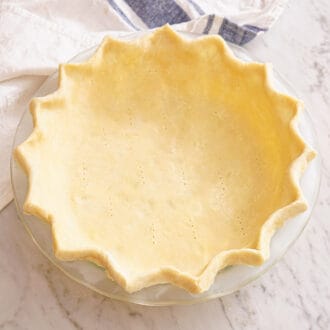
Pie Crust Recipe
All you need are a few ingredients to make this buttery and flaky homemade Pie Crust. It's so easy to make from scratch, you won't buy one from the store again!
Servings 2 (9-inch) pie crusts
Calories 1519kcal
Equipment
- Food Processor
- Plastic wrap
Ingredients
- 3 cups all-purpose flour divided (360g)
- 1 tablespoon granulated sugar
- 1 teaspoon salt
- 1 cup cold unsalted butter cut into cubes (227g)
- 4 to 6 tablespoons ice water (60-90ml)
Instructions
- In the work bowl of a food processor, combine 1½ cups (180g) of flour, sugar, and salt. Pulse a few times to combine.
- Add half of the butter. Process until very crumbly and starting to ball up, about 30 seconds. Scatter in the remaining butter and the remaining 1½ cups of flour. Pulse 2 times just to distribute.
- Drizzle 4 tablespoons (60ml) of ice water over the mixture. Pulse a few times. Add additional water, a tablespoon at a time, as needed, and pulse once or twice after each addition. The mixture should easily stick together when squeezed, but not feel wet or dry.
- Transfer the dough onto the counter and form into a ball. Cut the ball in half and press each half into a disc. Wrap tightly in plastic wrap and refrigerate for at least 1 hour or up to 3 days. The disks can also be frozen for a few months and thawed in the fridge overnight before using.
Video
Notes
- Can I make this ahead of time? Yes! Since pie dough keeps well in the fridge for up to 3 days, I often make the dough at least a day before I plan to make the pie. (It makes pie baking day that much easier!) After that, it may start to turn grey as the flour and butter oxidize. For longer storage, freeze the discs for up to 6 months.
- Use this dough for a sweet or savory pie recipe! Even though there's a small amount of sugar in the crust, this pie dough isn't sweet. It works as well for quiche as it does for pumpkin pie!
Nutrition
Calories: 1519kcal | Carbohydrates: 149g | Protein: 20g | Fat: 94g | Saturated Fat: 59g | Polyunsaturated Fat: 4g | Monounsaturated Fat: 24g | Trans Fat: 4g | Cholesterol: 244mg | Sodium: 1181mg | Potassium: 228mg | Fiber: 5g | Sugar: 7g | Vitamin A: 2836IU | Calcium: 57mg | Iron: 9mg